A Global Convergence on the Coast of France: ISEND 2011
By Nancy Zeller
April 2011, in the French seaport of La Rochelle, on the eastern edge of the Atlantic Ocean, more than 500 people from 56 countries convened for ISEND2011, the International Symposium and Exhibition on Natural Dyes.
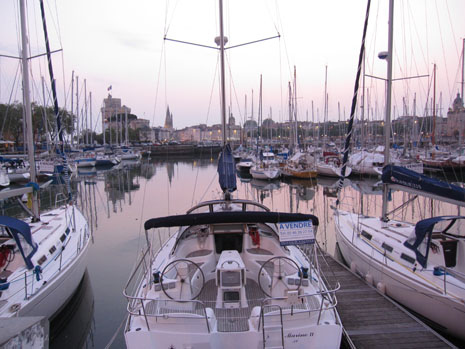
La Rochelle, meaning "small rock" has had a unique history. In 1199 the city elected the first mayor, a Protestant, while the rest of France was Catholic, thus earning the title of the "rebel city" and becoming a stronghold for Protestantism. During the Great Siege of 1627-1628, the city was forced to capitulate to the Royal troops, but soon regained prosperity with maritime trading, predominantly salt and wine to England, the Baltics, and Flanders. The Germans used La Rochelle's seaport during WWII, but the city was freed in 1945, and today is vibrant and successful with the sea as its backdrop. Indeed, I found it interesting to hear some in France describe La Rochelle as disappointing. Au contraire. I found La Rochelle to be a relaxed sea-side city, with good seafood, local wines and much to see and enjoy as a visitor. From most vantage points in the inner harbor area, the medieval Lantern Tower lighthouse flashes its beacon four points to the sea.
As a natural dyer, I was eager to attend ISEND2011, to meet and share knowledge on the art of natural dyes. I had spent two weeks in France in 2010 with a small group of friends from Earthues, Seattle, traveling and studying with natural dyers Michel Garcia of Lauris, and Denise Lambert of Bleu de Lectore. During the winter, a friend and I put together a trip that would include a week touring the Bordeaux Region before going to the symposium in La Rochelle. With the support of organizers ARRDHOR-CRITT Horticole and CIHAM, both France-based research centers, and the Scientific Committee of twelve, headed by Dr. Dominique Cardon and Anne de la Sayette, ISEND2011 took place at Espace Encan on a pier adjacent to the Aquarium La Rochelle. Formerly a fish market and heritage site, Espace Encan has been renovated by the City of La Rochelle and is a magnificent site for large venues. The amenities were grand, including a massive Bose sound system wired throughout the ceilings, an auditorium that would suit any type of audio/visual venue, and the foodservice capacity for more than 500 people in one seating. All events took place under one roof, with room to spare.
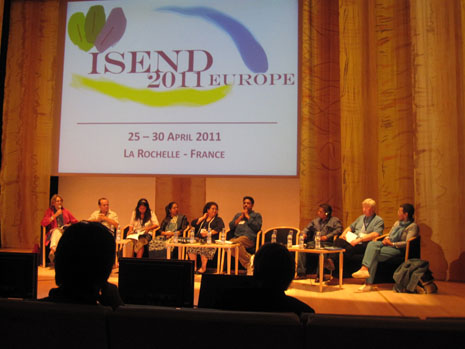
The week's program began the morning of April 25th, after the opening ceremony. The overall schedule included lectures in the auditorium with keynote presenters, from 9 AM to 12:30 PM, and a lunch break from 12:30 to 2 PM, followed by lectures from 2-3:30 PM. During the lectures two languages were available, French and English. If the lecturer spoke French, audience members were able to set the headset to an English translation. Considering the number of nationalities in the auditorium at any time, it was an excellent tool to aid in listening to the presenters and audience participation.
Each day from 3:30-6:30 PM there were simultaneous dyeing demonstrations, films and poster presentations, along with the open marketplace where vendors from around the world offered their products for sale. Lectures were organized under the following topics: Natural Dyes Across the Ages and Around the World; Textile Decoration Using Natural Dyes; Contributions of Archaeological and Anthropological Research Regarding Natural Dyes; a Roundtable on Natural Indigos; Biological Activities of Natural Colorants, Including Food Colorants; Recent Advances of Natural Colorants; the Economic and Social Impact of the Development of Natural Dyes, and the Valorization of Natural Colorants/ databanks, marketing, labels.
|
Boubacar Doumbia, Mali, demonstrating Basilan and Bogolan mud dyeing |
Exhibit Colour Purple, from the Atlantic to Faraway Shores at Aquarium La Rochelle |
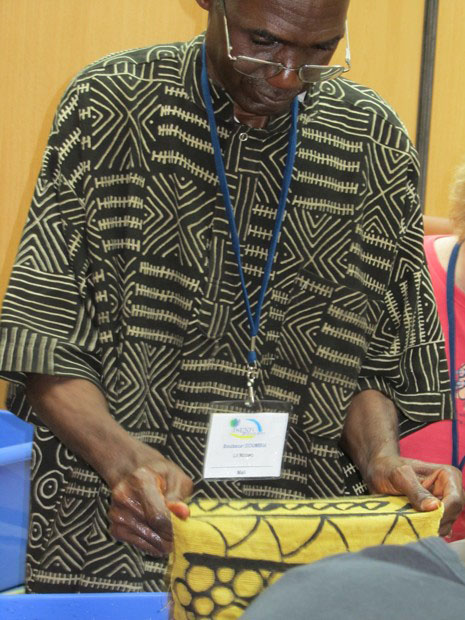 |
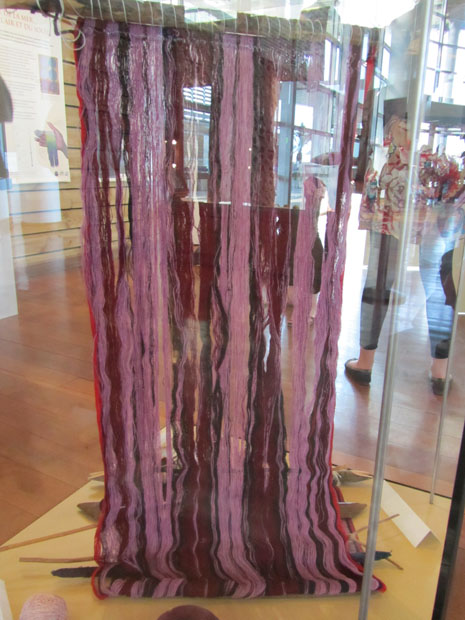 |
| Photograph Copyright by Nancy Zeller | Photograph Copyright by Nancy Zeller |
On the 27th, four morning excursions were available by advanced sign-up followed by a bag lunch at each excursion site. The four choices were a trip to the seashore that combined a visit an oyster farm, a seaside walk to identify native dye plants, and the experience of dyeing purple with Muricid molluscs; a countryside trip to include a dye plant farm and cattle grower; a tour of the CRITT/CDP extraction and application laboratory, plant collection and a tour of the School of Naval Medicine; and lastly a tour of La Rochelle's old city and Museum of Natural History with a point of view toward natural dyes.
Off-site, there were two exhibits offered to attendees. The first, at the Museum of Natural History in La Rochelle, highlighted their rich collection of plants and seashells used as color sources. The second, at the Aquarium La Rochelle, was Colour Purple, from the Atlantic to Faraway Shores, which provided background history and display of pieces dyed using the Muricid molluscs. There was a third exhibit at the Espace Escan: the Art and Fashion Exhibition. There one found the work of many talented artists using natural dyes, with 67 exhibitors displaying beautiful and inspiring work.
|
Art and Fashion Expo: Wen Chi Wu, Taiwan woven and naturally dyed |
Art and Fashion Expo: Ma-Li Chia, Taiwan Strobilanthes cusia on cotton/linen panels |
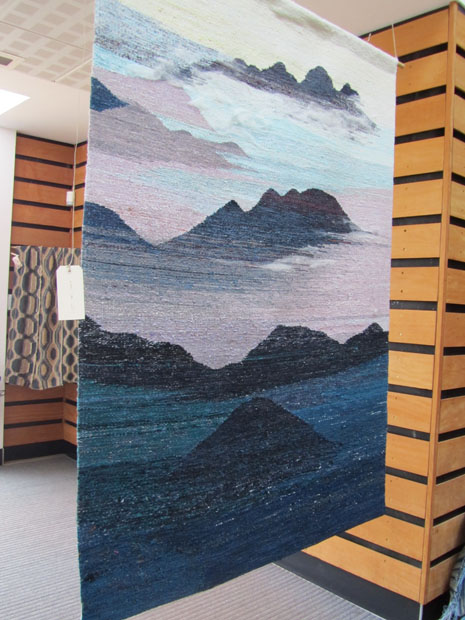 |
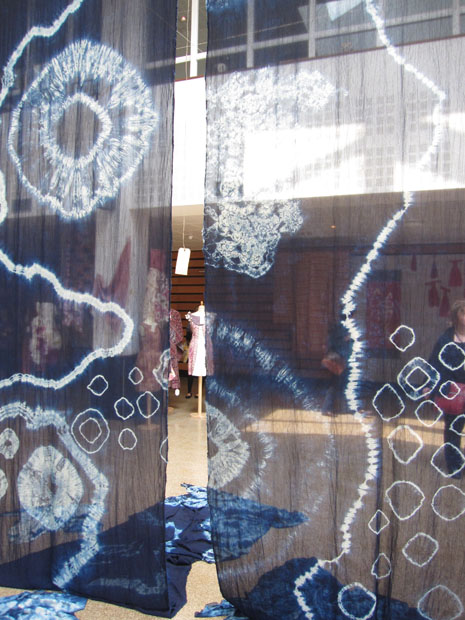 |
| Photograph Copyright by Nancy Zeller | Photograph Copyright by Nancy Zeller |
|
Art and Fashion Expo: Ajit Kumar Das, India handpainted with natural dyes |
Art and Fashion Expo: India Flint, Australia dress and cloth |
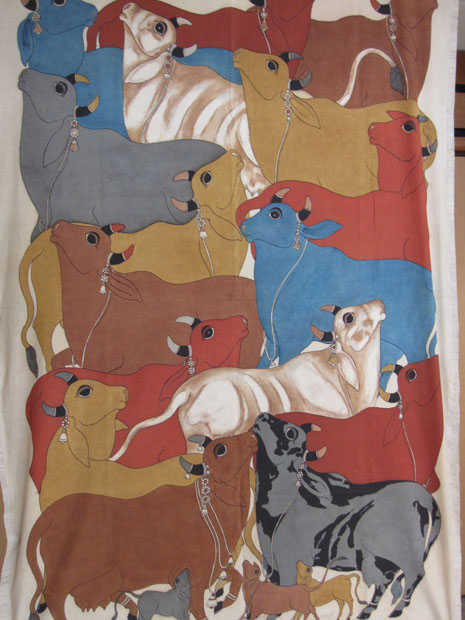 |
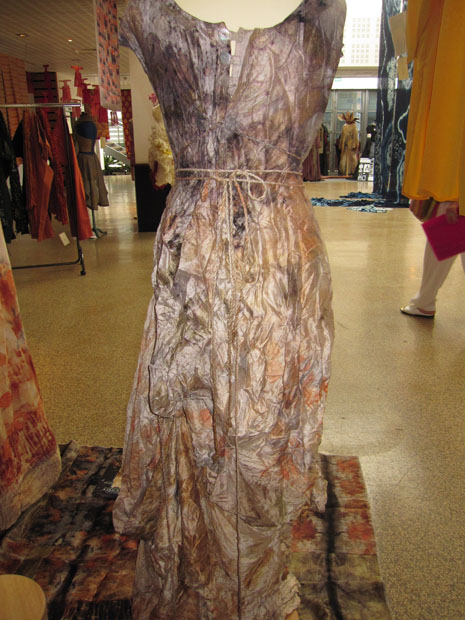 |
| Photograph Copyright by Nancy Zeller | Photograph Copyright by Nancy Zeller |
In addition to the above offerings, the Mayor of La Rochelle hosted a cultural event with acrobatic, tight-wire, choral and vocal performers dressed in naturally dyed costumes. There was free admission to the La Rochelle Aquarium and Museum of Natural History, and a festive Gala Dinner Evening to conclude the week, featuring French cuisine and dancing to two live bands, Akale Wube and Le Groupe Tres.
Having set the stage for the Symposium, I will share my thoughts about ISEND2011. I give five stars to the Symposium organizers and Espace Escan for all they did to make each of us comfortable all week. I was in awe of the effort put forth each day for lunch, serving 500 people in the dining room overlooking the harbor, the staff dressed elegantly in black and white, tables of set with full service, vegetarian or regular fare tables, and a three course meal, including red and white wines. I was both awestruck and grateful. At the Gala Dinner a resounding, standing show of support was given to the dining room staff.
I was equally pleased to be able to interact with artists, writers and others I have known only through their art, or in their writings. Our interactions continue since my return to the US.
For the off-site excursions, I chose the ocean tour as I was interested in the Muricid molluscs, or so I thought! For each excursion there were three to four large tour buses to take participants to the sites they had chosen. I had opted for the ocean and what it might provide. The first stop was an oyster farm, which was quite small, with too many of us trying to hear the guide and so, I stepped back and looked out over the ocean wall at the rocky beach.
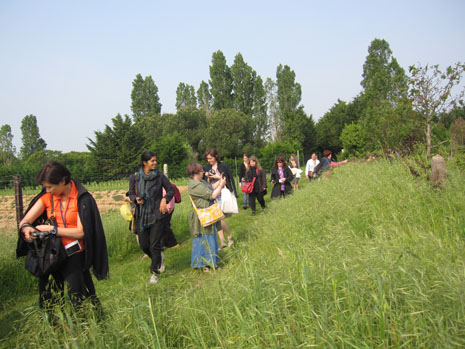
The next part of the excursion took us on a walk along the shoreline north of Fouras to observe native plant species suitable for dyeing. It was a preserved area with open fields and some wooded areas, where were able to see species up close, but again, there were too many people trying to be near the guides. I was pleased to see a few Wattle (Acacia) trees whose bark offers lovely hues, and other species such as Barberry (Berberis vulgaris), Goose Grass (Gallium aparine), Wild Cherry (Prunus avium), Yellow Crotal (Xanthoria parietina) and Wild Madder (Rubia peregrine). Slipping out through the hedgerow, I stood on the Atlantic's stony shoreline, in a lovely spot with fishing huts sitting high and pretty, awaiting the incoming tide.
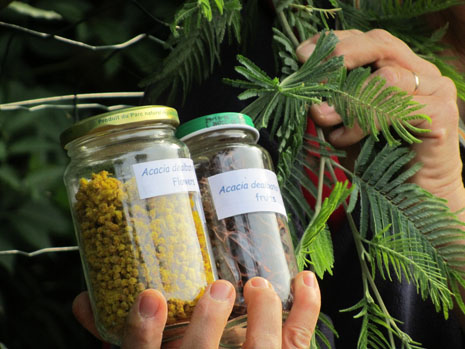
Stop three took us to the edge of the sea at Fouras, near Ile d'Aix. Here we spent an hour learning how to obtain purple dye from the Muricid molluscs. I quickly realized the process involved in this was not for me. The small creatures are gathered from the tidal areas, and then crushed with stones. The meat is then manipulated to extract the purple dye from the secretion of the hypobranchial gland. Less than one milligram of the liquid indigoid is yielded from one mollusc. If done properly, when the secretion is applied to cloth or another natural substrate, air and sunlight turn it purple. Imagine the number of molluscs needed to provide enough purple and you will understand why purple raiments were once reserved for royal, ceremonial and special occasions only. I was glad to move on. The buses from our excursion descended on a lovely park, overlooking the Atlantic. There were raw oysters and bag lunches for all. After an hour, we boarded the buses and returned to the Espace Escan for the afternoon's schedule.
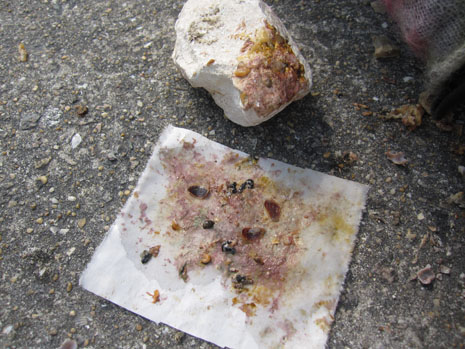
I was somewhat disappointed with the demonstration segments of the Symposium. With over five hundred attendees it was difficult to view a demonstration after the first ten or so people arrived at that booth, especially at the most popular venues. It might have been preferable to have sign-ups beforehand, and perhaps a larger area for each demonstration. There were some demonstrations by outstanding artists such as Yoshiko Wada, Michel Garcia, Boubacar Doumbia, Isabelle Clonier, Denise Lambert, Emily Halvorsen, Sandra Loeffelmann, Monoleena Banerjee and Trudi Pollard, to name just a few.
On the more positive side, I was able to shop the marketplace and find vendors from around the globe selling beautiful textiles and other items connected to the art of natural dyes. I bought a stunning, large cotton hand-painted stole in shades of indigo, created by the Bengali natural dye artist, Ajit Kumar Das. I also purchased one of his naturally dyed cloth paintings depicting family relationships through a group of sacred cows closely moving in joyful unison. It was a pleasure to shop at MAIWA, gathering some lovely leather journals and a naturally-dyed cotton coat. I found, and have been experimenting with, dried safflower, and had to buy a few woad balls to share, as an example of a composted dyestuff. It was a treat to wander about and view the natural dye world in one market.
During the lecture sessions there was much discussion about the certification, standardization and regulation of natural dyes, as well as creating a database for all natural dyes, industrializing the indigo process and preserving its ancestral knowledge. While these procedures would provide the uniformity essential for mass marketing, for me, they are the antithesis of what we love about natural dyes. Certification is expensive and directly affects the artisan, as does regulation and standardization. To implement standardization, the farmer of a natural dye crop must confirm, through laboratory testing, a color value of dye within each production batch. Who pays for this testing and who can we trust with the results? Certification is a valid process, but at what expense to the artisan who creates the product? We know well what regulation means in terms of manpower and additional expense. If we start to treat natural dyes as a mass-produced item with all the ensuing bureaucracy, we run the risk of endangering the artisans and farmers we depend on and risk the disappearance of these sources.
With dye plants, as with my breed of sheep, the CVM/Romeldale, the rarest and most endangered breed of sheep in North America today, when the breed vanishes, it's gone forever. I would like to see nurturing and careful management that respect "their" environment, rather than our needs. Stay conscious, stay concerned and never assume longevity.
 Turkey Red Journal
Turkey Red Journal
